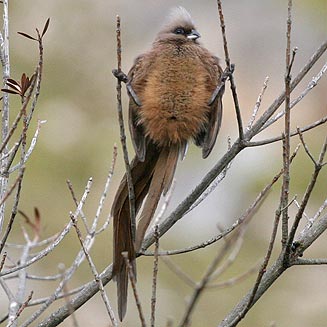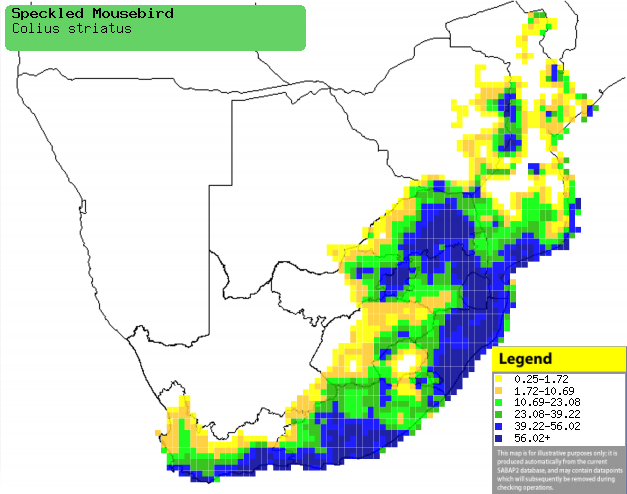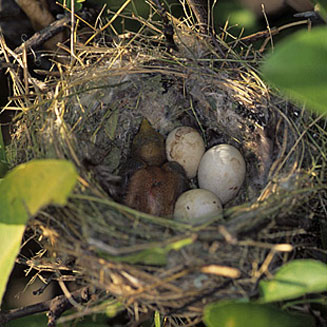|
Colius striatus (Speckled
mousebird)
Gevlekte muisvoël [Afrikaans]; Indlazi [Xhosa]; iNdlazi
[Zulu]; Fariki (generic term for mousebirds) [South Sotho]; Tshivhovo [Tsonga];
Bruine muisvogel [Dutch]; Coliou rayé [French]; Braunflügel-mausvogel
[German]; Rabo-de-junco-de-peito-barrado [Portuguese]
Life
> Eukaryotes >
Opisthokonta
> Metazoa (animals) >
Bilateria >
Deuterostomia > Chordata >
Craniata > Vertebrata (vertebrates) > Gnathostomata (jawed
vertebrates) > Teleostomi (teleost fish) > Osteichthyes (bony fish) > Class:
Sarcopterygii (lobe-finned
fish) > Stegocephalia (terrestrial
vertebrates) > Tetrapoda
(four-legged vertebrates) > Reptiliomorpha > Amniota >
Reptilia (reptiles) >
Romeriida > Diapsida > Archosauromorpha > Archosauria >
Dinosauria
(dinosaurs) > Saurischia > Theropoda (bipedal predatory dinosaurs) >
Coelurosauria > Maniraptora > Aves (birds) > Order: Coliiformes >
Family: Coliidae
 |
|
| Speckled mousebird, Kleinmond, Western Cape,
South Africa. [photo
Duncan Robertson ©] |
|
The Speckled mousebird is common in South Africa and
Mozambique, where it is common in suburban gardens. It is highly adaptable, and
can be found in many types of habitats. It feeds on plant matter, mainly fruit,
but also leaves, nectar and buds. The breeding pair is helped by 2-6 helpers,
normally half of which are not related. The nest is a small bowl of grass, lined
with soft material. It lays 1-7 eggs, which are incubated by both sexes, for
12-15 days. The nestlings start to explore the branches surrounding the nest at
10-11 days, staying in the nest for the first 4-10 days more, after which they
become independent.
Distribution and habitat
Occurs from Cameroon to Ethiopia south, through southern
DRC, Tanzania, northern Zambia and northern Angola to southern Africa. Within
southern Africa it is common in eastern Zimbabwe, Mozambique and South Africa,
largely excluding the arid Northern Cape. It is very adaptable, occurring in forest edges, thickets, gardens, orchards, strandveld, riverine
woodland and alien tree plantations.
|
 |
|
Distribution of Speckled mousebird in southern Africa,
based on statistical smoothing of the records from first SA Bird Atlas
Project (©
Animal Demography unit, University of
Cape Town; smoothing by Birgit Erni and Francesca Little). Colours range
from dark blue (most common) through to yellow (least common).
See here for the latest distribution
from the SABAP2. |
Predators
Brood parasites
It has been recorded as host of the
Jacobin cuckoo.
Food
It feeds on a wide variety of plant
matter, especially fruit but also flowers, nectar, leaves, buds and dead bark. It
usually forages in the mid to upper tree canopy, often in groups of 5-20
birds. The following food items have been recorded in its diet:
- Plants
- fruits
- mistletoes (Loranthaceae and Viscaceae)
- leaves
- peaches
-
Acacia
- Lycium (honey-thorns)
- Senecio pleistocephalus (Scrambling senecio)
- flowers
- buds
- dead bark
- nectar
- Aloe marlothii (Mountain aloe)
- Aloe arborescens (Krantz aloe)
- Aloe ferox (Bitter aloe)
- Erythrina latissima (Broad-leaved coral-tree)
Breeding
- Can be monogamous or polygamous,
meaning that the male can have one ore multiple mates. It is also
a cooperative breeder, with 2-6 juvenile helpers, some of which are
not related to the breeding couple. Courtship is fairly elaborate, with
preening, bouncing up and down on perch and exchanging of food.
- The nest is a small, shallow bowl made of grass and herb stems, lined
with soft material. It is typically placed 1-7 metres above ground in a tree
or bush.
 |
|
|
Speckled mousbird nest with eggs and chick,
Sericea farm, South Africa. [photo
Warwick Tarboton ©] |
|
- Egg-laying season is from July-April, peaking from September-January.
- It lays 1-7, usually 2-4 eggs, which are incubated by both sexes for
12-15 days. The pair change over every 0.5-2.0 hours, accompanied with a
ritual display in which they both show open their beaks to show their gape.
- The chicks are fed by both parents on a diet of regurgitated plant
material mixed with the chick's faeces, that the parents had eaten
previously.
- The nestlings start to explore the branches surrounding the nest at
about
10-11 days old, after which they start to preen each other. They stay in the
nest 15-20 days, after which they become independent.
Threats
Not threatened, in fact has benefited greatly from the
spread of suburban gardens. It is regularly roadkilled, but this does not seem to
have a significant affect on its population.
References
-
Hockey PAR, Dean WRJ and Ryan PG (eds) 2005. Roberts
- Birds of southern Africa, VIIth ed. The Trustees of the John Voelcker
Bird Book Fund, Cape Town.
|
